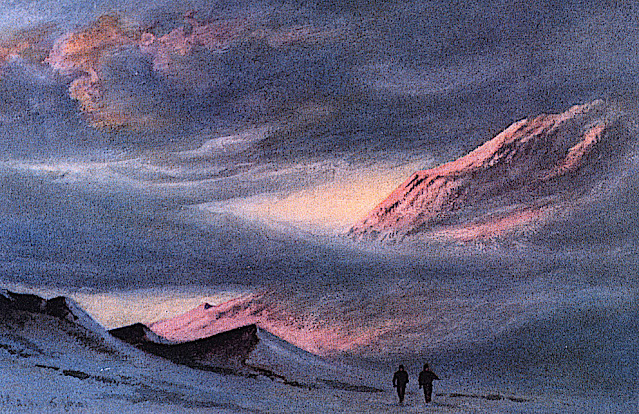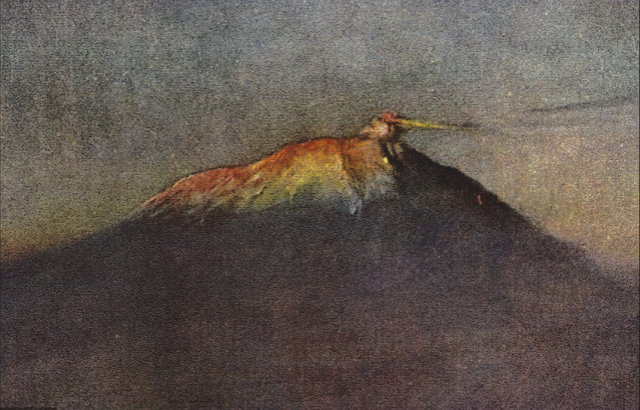CHARLES HAMILTON SMITH (1776-1859)
Mont Erebus (3, 794 m - 12, 448ft)
Antarctica (Ross Island)
In Mount Erebus and Beaufort Island- Watercolour from Views of Polar region,
Yale Center for British arts, Connectitcut, USA
The mountain
Mount Erebus (3, 794 m - 12, 448ft), not to be confused with
Mount Elbrus is the second-highest volcano in Antarctica (after
Mount Sidley)
and the southernmost active volcano on Earth. It is the sixth highest
ultra mountain on an island, located on Ross Island, which is also home
to three inactive volcanoes:
Mount Terror, Mount Bird, and Mount Terra Nova.
The volcano has been active since c. 1.3 million years ago and is the
site of the Mount Erebus Volcano Observatory run by the New Mexico
Institute of Mining and Technology.
Mount Erebus was discovered on January 27, 1841 (and observed to be in
eruption) by polar explorer Sir James Clark Ross who named it and its
companion, Mount Terror, after his ships, Erebus and Terror (which were
later used by Sir John Franklin on his disastrous Arctic expedition).
Erebus is a dark region in Hades in Greek mythology. Present with Ross
on the Erebus was the young Joseph Hooker, future president of the Royal
Society and close friend of Charles Darwin. Erebus was an Ancient Greek
primordial deity of darkness, the son of Chaos.
The mountain was surveyed in December 1912 by a science party from
Scott’s Terra Nova Expedition who also collected geological samples. Two
of the camp sites they used have been recognised for their historic
significance:
- Upper “Summit Camp” site (HSM 89) consists of part of a circle of rocks, which were probably used to weight the tent valances.
- Lower “Camp E” site (HSM 90) consists of a slightly elevated area of
gravel as well as some aligned rocks, which may have been used to weight
the tent valances.
They have been designated Historic Sites or Monuments following a
proposal by the United Kingdom, New Zealand and the United States to the
Antarctic Treaty Consultative Meeting.
Mount Erebus is classified as a polygenetic stratovolcano. The bottom
half of the volcano is a shield and the top half is a stratocone. The
composition of the current eruptive products of Erebus is
anorthoclase-porphyritic tephritic phonolite and phonolite, which are
the bulk of exposed lava flow on the volcano. Erebus is the world's
only presently erupting phonolite volcano.
The artist
Lieutenant-Colonel Charles Hamilton Smith, was an English artist,
naturalist, antiquary, illustrator, soldier, and... spy as well !. His
military career began in 1787, when he studied at the Austrian academy
for artillery and engineers at Mechelen and Leuven in Belgium (his
native country). Although his military service, which ended in 1820 and
included the Napoleonic Wars, saw him travel extensively (including the
West Indies, Canada, United States, Southern and Northern Europe and
...Antarctica).
As a prolific self-taught illustrator (over 38,000 drawings!) He left
quite an important number of books of beautifully watercolored
landscapes taken all around the world. those nooks of watercolors are
nowadays in the collections of the Yale Center From British Art. Among
them :
- Views of France, Volume I (81 watercolors), Views of France, Volume II (93 watercolors),
- Views of England and Wales, Volume I (82 watercolors), Views of England and Wales, Volume II (74 watercolors),
- Views of Northern Europe, Volume I (68watercolors) , Views of Northern Europe, Volume II (78) watercolors),
- Views of Polar Regions (75 watercolors) (see above)
- Views of Spain, Volume I (69 watercolors), Views of Spain, Volume II (72 watercolors),
But one of his noteworthy achievements was an 1800 experiment to
determine which color should be used for military uniforms. He is also
known in military history circles for
Costume of the Army of the British Empire, produced towards the end of the Napoleonic Wars and an accurate depiction of contemporary British uniform.
As an antiquarian, he also produced, in collaboration with Samuel Rush Meyrick, Costume of the Original Inhabitants of the British Islands, 1815, and The Ancient Costume of England, with historical illustrations of medieval knights, ladies, shipsm and battles.
He also wrote on the history of the Seven Years' War and TheNatural history of dogs.
Quite a productive fellow !
___________________________________________
2019 - Wandering Vertexes...
by Francis Rousseau

















